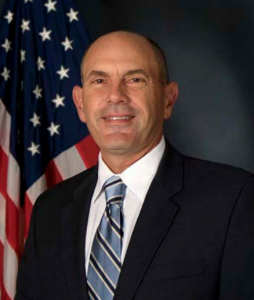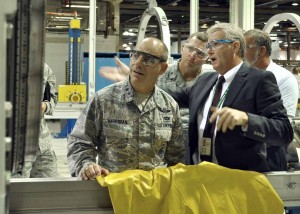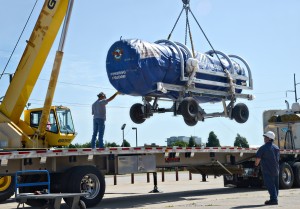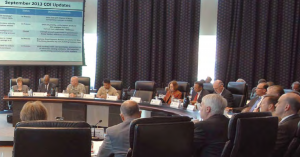2015-07-13 By Robbin Laird
Twenty First century air systems are building new approaches to sustainability.
But if the services worldwide do not transform their approach to logistics and sustainability then the gains built into these systems will not be realized.
Clearly, the leadership of DLA Aviation of the Defense Logistics Agency understands the importance of shaping a transition from legacy to 21st century systems, and is working with industry to shape new ways to sustain a 21st century force.
DLA Aviation is working closely with the services in shaping new approaches to provide for support for 21st century combat systems.
To gain an appreciation of the approach, Charles Lilli, the Deputy Commander of DLA Aviation, was interviewed and provided a sense of the progress and the challenges for the way ahead.
Lilli has a background in both the services, industry and in government and as such is well placed to understand the challenge of transition. He served in the US Navy for 28 years and retired as a Rear Admiral and worked in many aspects of sustainment and support. He then joined Lockheed Marin where he was the director of Sustainment and Supply Chain Integration for Lockheed Martin. And in the Fall of 2012 was named Deputy Commander of DLA Aviation.

DLA Aviation supports more than 1,800 weapon systems and is the U.S. military’s integrated materiel manager million national stock number items, industrial retail supply and depot-level repairable acquisitions. Mr. Lilli, along with the DLA Aviation commander, oversees an aviation demand chain responsible for more than $4.4 billion in annual sales.
Positioned alongside its military customers, DLA Aviation manages industrial support activities at Robins Air Force Base, Ga., Tinker AFB, Okla., Hill AFB, Utah, Marine Corps Air Station Cherry Point, N.C., Naval Air Station North Island, Calif., and NAS Jacksonville, Fla.
DLA Aviation also manages depot-level repairable procurement operations at Robins, Tinker and Hill Air Force Bases; Naval Supply Systems Command (NAVSUP) Weapon Systems Support, Philadelphia; and at Redstone Army Arsenal, Ala.
DLA Aviation also operates an industrial plant equipment maintenance, repair and overhaul facility at Mechanicsburg, Pa.
Question: Since you have joined DLA, could you highlight some examples of progress made to shape a more effective logistics approach?
Lilli: That is a tough question.
But over the last couple of years we have developed innovative contracts that incentivize industry to work collaboratively with us to reduce material cost, improve material availability, reduce material lead times and share any additional savings generated over the life of the contract.
For example, we have a performance based contract in place with Boeing. The contract is a Fixed Price Incentive based contract that has moved us from purchasing parts to the procurement of material support for all Boeing’s sole source products to the military services.
To make the award, we started with a detailed analysis of the demand and material costs for those items in the previous 2 years. With that data we calculated the actual cost and then through some additional simulation projected what it would cost us to continue that same support. That value became the upper limit of the negotiation target for the award.
At the negotiation table, we got Boeing to agree to provide the same service at a lower price and the contract includes incentives to ensure that occurs. The total savings for the government are estimated at over 20%.
Question: You’re making a best case assessment based on past practices, and what it would cost you to do operate the next fiscal year in a particular domain.
And then you’re looking to industry to give you a better price and to maintain the level of performance, based on their unique knowledge of the technology and specific supply base.
That knowledge and a long term agreement allow them to drive the price down.
That’s essentially what that contract is doing?
Lilli: That is exactly what it does.

Question: There are programs like the Osprey program that have global sales opportunities but need an appropriate sustainment structure. What is the state of play with regard to Osprey sustainment?
Lilli: The original sustainment concept for the V22 was commercial support, like the F-35. The idea was to pay Bell-Boeing for the plane to be sustained operationally.
But the approach has shifted to a more traditional approach where DoD will maintain the system through its life cycle.
But regardless of the support strategy, the original equipment manufacturers (OEM’s) play a significant and important role and they must be incentivized to keep the parts flowing in sufficient quantity and quality to operate the aircraft worldwide.
The only way industry can be incentivized to make investment in any type of sustainment beyond production, and to address obsolescence early enough in the system life to make a difference, is to put in place long term contracts specifically designed to do just that.
The goal is to keep the OEM’s involved so that they don’t just sell out the rights when the production gets cold.
I think that’s a strategy that we have to continue to pursue.
Question: The depots are not going away but you are working new ways to integrate industry with the depots to deliver a more performance-based logistics approach.
Could you provide a sense of how you are going about doing this?
Lilli: Working closely with our service partners, we are working on new approaches and contractual arrangements.
For example, we are shaping a new working relationship between General Electric and Tinker Air Force Base (Air Force Sustainment Center) to cover the F101 Service Life Extension Program (SLEP) process.
http://www.tinker.af.mil/library/factsheets/factsheet.asp?id=9404
http://www.geaviation.com/military/engines/f110/
GE is delivering a SLEP program to the USAF for F series engines. We are preparing to buy the SLEP kits from GE under contract and actually going to bring GE into the depot.
It’s not a new concept and has been effective in the past.
The idea is for commercial industry to work with our organic depots in order to introduce more efficient and streamlined maintenance processes.

In addition, we will put them on contract to work closely with the service engineering community who is responsible for safety of flight, introduce suggested reliability improvements for the engines.
It’s important to note that for DLA to do this work, we have to work closely with the military service, in this case the Air Force to provide them what they need and we believe that the end result will allow an unprecedented level of partnership between the government and industry.
GE has indicated that in the future, if the relationship proves successful, they could use Tinker to make the repairs to engines they currently repair for various international military customers in commercial depots.
That would be a huge win for Air Force.
Question: A key challenge to shape a 21st century logistics approach is to get beyond service stove piping and service specific approaches even when they are buying common equipment.
This challenge is already evident with F-35 and as procurement favors a smaller number of common multi-mission programs, getting more commonality out of support is crucial.

How are you trying to encourage change in this area?
Lilli: It is a major challenge.
There is no doubt that many of our current or historically inherited support systems can stand some improvement.
As you mentioned in your question, DoD is trying to move to a single support strategy for the JSF, in order to gain efficiencies at the platform level, but different service culture and business practices make getting to a single solution challenging.
For example, we are taking it on at the component level through a contract with Honeywell that is designed to provide for PBL support auxiliary power units and a couple of other components common to Army, Navy and the Air Force.
It’s sort of JSF-lite, but it may be a way to break through some of services differences at the component level and demonstrate the potential savings that can be achieved with an enterprise wide approach.
Question: How has the DLA Captains of Industry worked to generate innovation as well?
Lilli: The Captains of Industry program was launched in 2012 and provides a venue for industry to meet with DLA leadership to suggest ways to enhance sustainment at lower cost. Industry is encouraged to submit ideas about how to look at the problems from their perspective and provide solutions for going forward.
Industry has come back with a number of innovative solutions, and the Honeywell approach to APU support was one product of this process.

